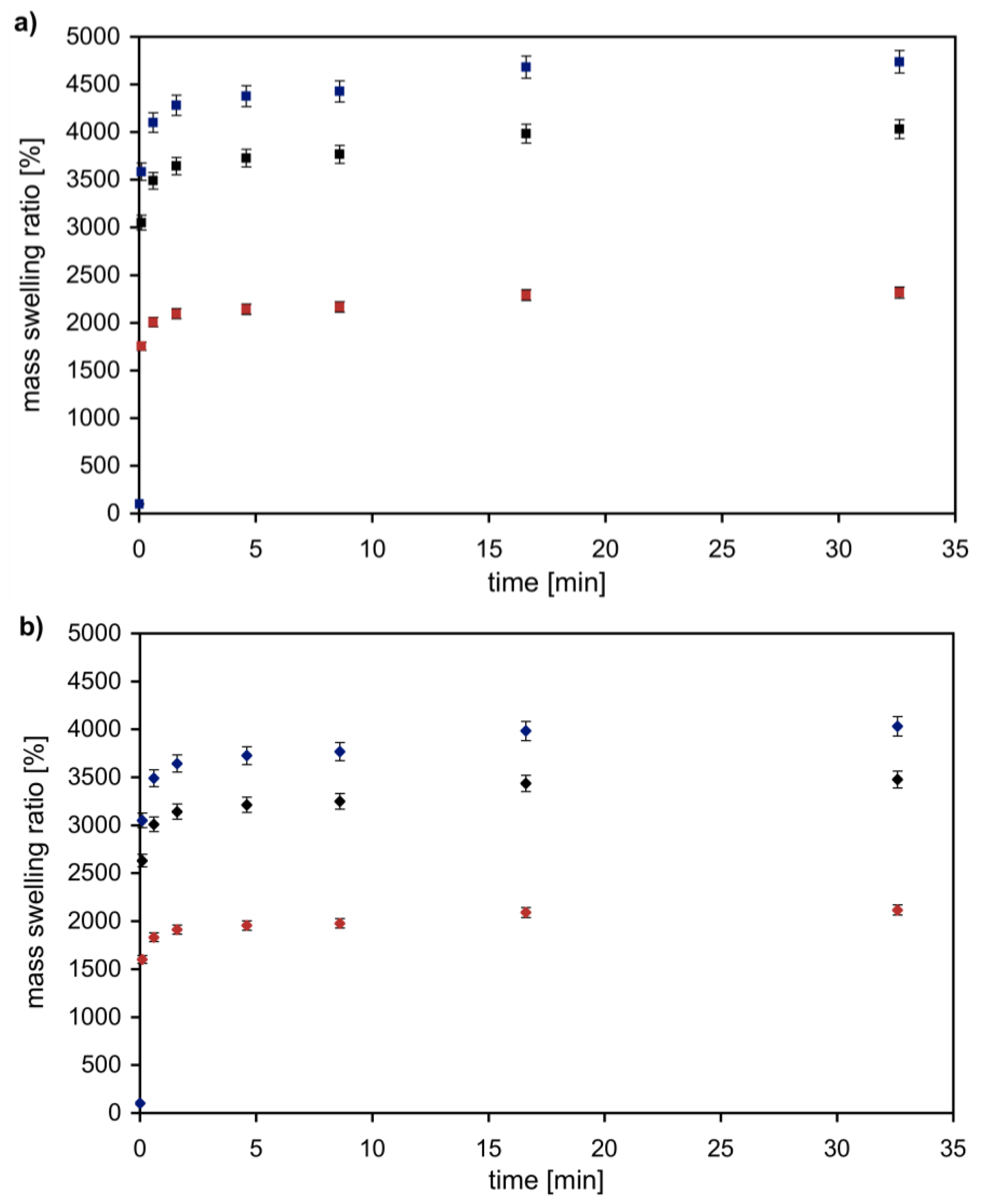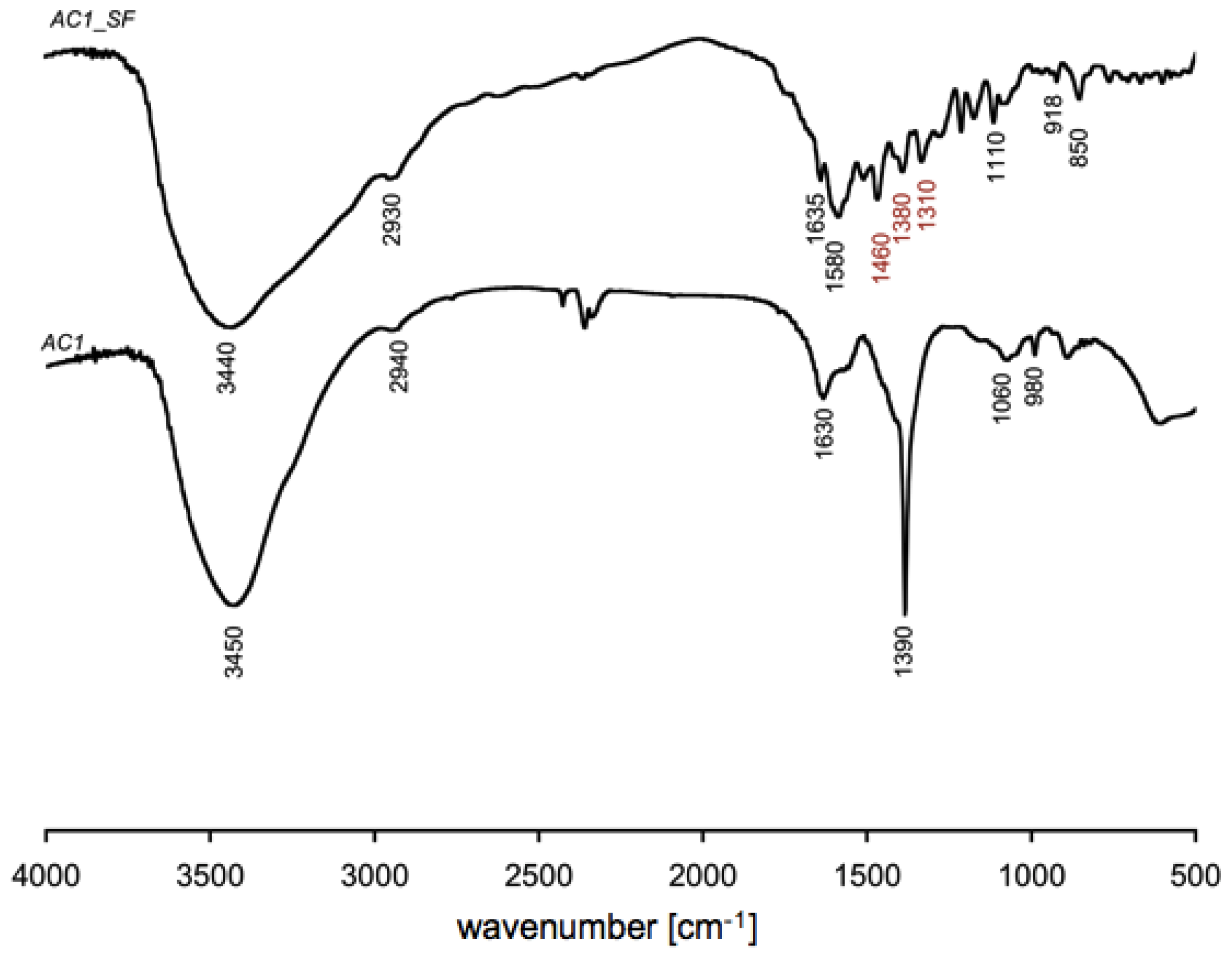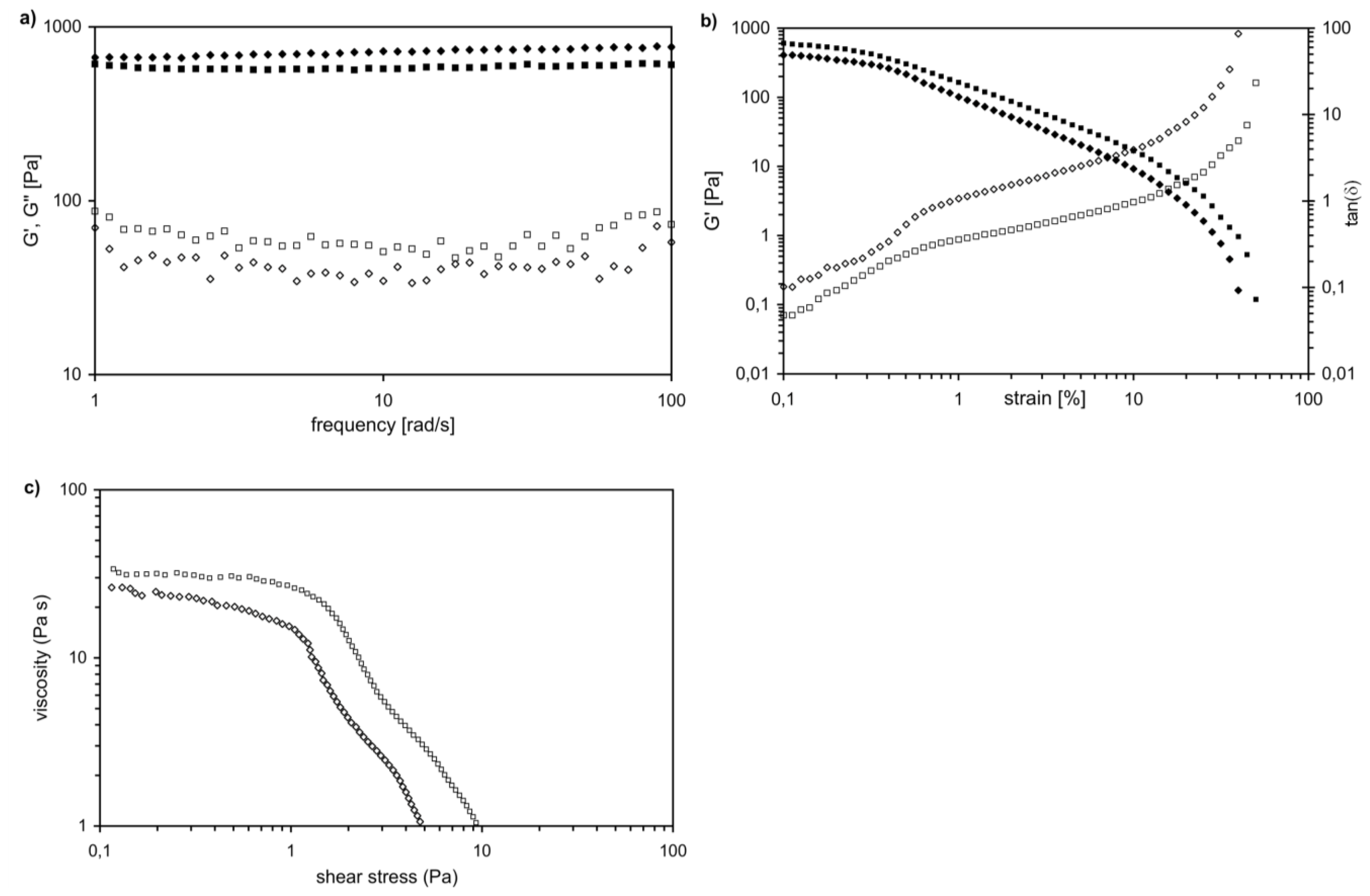Characterization and Degradation Behavior of Agar–Carbomer Based Hydrogels for Drug Delivery Applications: Solute Effect
Abstract
:1. Introduction
2. Results and Discussions
2.1. Drug Delivery
2.2. Material Characterization
2.2.1. Swelling Behavior
2.2.2. Fourier Transform Infrared Spectroscopy (FT-IR)
2.2.3. Rheology
2.3. Hydrogel Degradation
3. Experimental Studies
3.1. Materials
3.2. Hydrogel Synthesis
3.3. Drug Loading
3.4. Release Experiments
3.5. Physical Characterization
3.5.1 Swelling Behavior
3.5.2. FTIR Spectra
3.5.3. Rheological Measurements
3.6. Degradation
3.6.1. FT-IR Analysis
3.6.2. Mass Loss Kinetic
3.7. Statistical Analysis
4. Conclusions
Acknowledgments
References
- Langer, R; Vacanti, JP. Tissue engineering. Science 1993, 260, 920–926. [Google Scholar]
- Sakurada, K; McDonald, FM; Shimada, F. Regenerative medicine and stem cell based drug discovery. Angew. Chem. Int. Edit 2008, 47, 5718–5738. [Google Scholar]
- Atala, R; Langer, R; Thomson, J; Nerem, R. Principles of Regenerative Medicine; Academic Press: Burlington, MA, USA, 2008. [Google Scholar]
- Shoichet, MS. Polymer scaffolds for biomaterials applications. Macromolecules 2010, 43, 581–591. [Google Scholar]
- Engel, E; Michiardi, A; Navarro, M; Lacroix, D; Planell, JA. Nanotechnology in regenerative medicine: The materials side. Trends Biotech 2008, 26, 39–47. [Google Scholar]
- Langer, R. Perspectives and challenges in tissue engineering and regenerative medicine. Adv. Mater 2009, 21, 3235–3236. [Google Scholar]
- Ye, Z; Zhou, Y; Cai, H; Tan, W. Myocardial regeneration: Roles of stem cells and hydrogels. Adv Drug Deliv Rev 2011, in press. [Google Scholar]
- Mei, Y; Saha, K; Bogatyrev, SR; Yang, J; Hook, AL; Kalcioglu, ZI; Cho, SW; Mitalipova, M; Pyzocha, N; Rojas, F; van Vliet, KJ; Davies, MC; Alexander, MR; Langer, R; Jaenish, R; Anderson, DG. Combinatorial development of biomaterials for clonal growth of human pluripotent stem cells. Nature Mater 2010, 9, 768–778. [Google Scholar] [Green Version]
- Kim, YT; Caldwell, JM; Bellamkonda, RV. Nanoparticle-mediated local delivery of methylprednisolone after spinal cord injury. Biomaterials 2009, 30, 2582–2590. [Google Scholar]
- Baumann, MD; Kang, CE; Stanwick, JC; Wang, YF; Kim, H; Lapitsky, Y; Shoichet, MS. An injectable drug delivery platform for sustained combination therapy. J. Control. Release 2009, 138, 205–213. [Google Scholar]
- Baumann, MD; Kang, CE; Tator, CH; Shoichet, MS. Intrathecal delivery of a polymeric nanocomposite hydrogel after spinal cord injury. Biomaterials 2010, 31, 7631–7639. [Google Scholar]
- Slaughter, BV; Khurshid, SS; Fisher, OZ; Khademhosseini, A; Peppas, NA. Hydrogels in regenerative medicine. Adv. Mater 2009, 21, 3307–3329. [Google Scholar]
- Malafaya, PB; Silva, GA; Reis, RL. Natural-origin polymers as carriers and scaffolds for biomolecules and cell delivery in tissue engineering applications. Adv. Drug Deliv. Rev 2007, 59, 207–233. [Google Scholar]
- Mano, JF; Silva, GA; Azevedo, HS; Malafaya, PB; Sousa, RA; Silva, SS; Boesel, LF; Oliveira, JM; Santos, TC; Marques, AP; Neves, NM; Reis, RL. Natural origin biodegradable systems in tissue engineering and regenerative medicine: Present status and some moving trends. J. R. Soc. Interface 2007, 4, 999–1030. [Google Scholar]
- Hejcl, A; Sedy, J; Kapcalova, M; Toro, DA; Amemori, T; Lesny, P; Likavcanova-Masinova, K; Krumbholcova, E; Pradny, M; Michalek, J; Burian, M; Hajek, M; Jendelova, P; Sykova, E. HPMA-RGD hydrogels seeded with mesenchymal stem cells improve functional outcome in chronic spinal cord injury. Stem Cells Dev 2010, 19, 1535–1546. [Google Scholar]
- Tabata, Y. Biomaterial technology for tissue engineering applications. J. R. Soc. Interface 2009, 6, S311–S324. [Google Scholar]
- Tan, HP; Chu, CR; Payne, KA; Marra, KG. Injectable in situ forming biodegradable chitosan-hyaluronic acid based hydrogels for cartilage tissue engineering. Biomaterials 2009, 30, 2499–2506. [Google Scholar]
- Hoare, TR; Kohane, DS. Hydrogels in drug delivery: Progress and challenges. Polymer 2008, 49, 1993–2007. [Google Scholar]
- Pritchard, CD; O’Shea, TM; Siegwart, DJ; Calo, E; Anderson, DG; Reynolds, FM; Thomas, JA; Slotkin, JR; Woodard, EJ; Langer, R. An injectable thiol-acrylate poly(ethylene glycol) hydrogel for sustained release of methylprednisolone sodium succinate. Biomaterials 2011, 32, 587–597. [Google Scholar]
- Santoro, M; Marchetti, P; Rossi, F; Perale, G; Castiglione, F; Mele, A; Masi, M. A smart approach to evaluate drug diffusivity in agar-carbomer hydrogels for drug delivery. J. Phys. Chem. B 2011, 115, 2503–2510. [Google Scholar]
- Rossi, F; Chatzistavrou, X; Perale, G; Boccaccini, AR. Synthesis and degradation of agar–carbomer based hydrogels for tissue engineering appliactions. J Appl Polym Sci 2011, in press. [Google Scholar]
- Rossi, F; Perale, G; Masi, M. Biological buffered saline solution as solvent in agar–carbomer hydrogel synthesis. Chem. Pap 2010, 64, 573–578. [Google Scholar]
- Perale, G; Giordano, C; Bianco, F; Rossi, F; Daniele, F; Tunesi, M; Crivelli, F; Matteoli, M; Masi, M. Hydrogel for cell housing in the brain and in the spinal cord. Int. J. Artif. Organs 2011, 34, 295–303. [Google Scholar]
- Perale, G; Veglianese, P; Rossi, F; Peviani, M; Santoro, M; Llupi, D; Micotti, E; Forloni, G; Masi, M. In situ agar–carbomer polycondensation: A chemical approach to regenerative medicine. Mater. Lett 2011, 65, 1688–1692. [Google Scholar]
- Perale, G; Rossi, F; Sundstrom, E; Bacchiega, S; Masi, M; Forloni, G; Veglianese, P. Hydrogels in spinal cord injury repair strategies. ACS Chem Neurosci 2011, in press. [Google Scholar]
- Perale, G; Arosio, P; Moscatelli, D; Barri, V; Muller, M; Maccagnan, S; Masi, M. A new model of resorbable device degradation and drug release: Transient 1-dimension diffusional model. J. Control. Release 2009, 136, 196–205. [Google Scholar]
- Singh, TRR; Woolfson, AD; Donnelly, RF. Investigation of solute permeation across hydrogels composed of poly(methyl vinyl ether-co-maleic acid) and poly(ethylene glycol). J. Pharm. Pharmacol 2010, 62, 829–837. [Google Scholar]
- Rodriguez-Tenreiro, C; Alvarez-Lorenzo, C; Rodriguez-Perez, A; Concheiro, A; Torres-Labandeira, JJ. Estradiol sustained release from high affinity cyclodextrin hydrogels. Eur. J. Pharm. Biopharm 2007, 66, 55–62. [Google Scholar]
- Koutsopoulos, S; Unsworth, LD; Nagaia, Y; Zhang, SG. Controlled release of functional proteins through designer self-assembling peptide nanofiber hydrogel scaffold. Proc. Natl. Acad. Sci. USA 2009, 106, 4623–4628. [Google Scholar]
- Bracken, MB; Shepard, MJ; Collins, WF; Holford, TR; Young, W; Piepmeier, J; Leosummers, L; Baskin, DS; Eisenberg, HM; Flamm, E; Marshall, LF; Maroon, J; Wilberger, J; Perot, PL; Sonntag, VKH; Wagner, FC; Winn, HR. A randomized, controlled trial of methylprednisolone or naloxone in the treatment of acute spinal-cord injury. New Engl. J. Med 1990, 323, 1209–1209. [Google Scholar]
- Cao, K; Huang, L; Liu, JW; An, H; Shu, Y; Han, ZM. Inhibitory effects of high-dose methylprednisolone on bacterial translocation from gut and endotoxin release following acute spinal cord injury-induced paraplegia in rats. Neur. Regen. Res 2010, 5, 456–460. [Google Scholar]
- Wen, H; Park, K. Oral Controlled Release Formulation Design and Drug Delivery: Theory to Practice; Wiley: Hoboken, NJ, USA, 2010. [Google Scholar]
- Wang, L; Roitberg, A; Meuse, C; Gaigalas, AK. Raman and FTIR spectroscopies of fluorescein in solutions. Spectrochim. Acta A 2001, 57, 1781–1791. [Google Scholar]
- Barbucci, R; Pasqui, D; Favaloro, R; Panariello, G. A thixotropic hydrogel from chemically cross-linked guar gum: Synthesis, characterization and rheological behaviour. Carbohydr. Res 2008, 343, 3058–3065. [Google Scholar]
- Vidovic, E; Klee, D; Hocker, H. Degradation behavior of hydrogels from poly(vinyl Alcohol)- graft-[poly(rac-lactide)/Poly(rac-lactide-co-glycolide)]: Influence of the structure and composition on the material’s stability. J. Appl. Polym. Sci 2009, 112, 1538–1545. [Google Scholar]
- Begam, T; Tomar, RS; Nagpal, AK; Singhal, R. Synthesis of poly(acrylamide-co-methyl methacrylate-co-vinyl amine-co-acrylic acid) hydrogels by Hoffman degradation and their interactions with acetaminophen. J. Appl. Polym. Sci 2004, 94, 40–52. [Google Scholar]
- Gupta, D; Tator, CH; Shoichet, MS. Fast-gelling injectable blend of hyaluronan and methylcellulose for intrathecal, localized delivery to the injured spinal cord. Biomaterials 2006, 27, 2370–2379. [Google Scholar]






© 2011 by the authors; licensee Molecular Diversity Preservation International, Basel, Switzerland. This article is an open-access article distributed under the terms and conditions of the Creative Commons Attribution license (http://creativecommons.org/licenses/by/3.0/).
Share and Cite
Rossi, F.; Santoro, M.; Casalini, T.; Veglianese, P.; Masi, M.; Perale, G. Characterization and Degradation Behavior of Agar–Carbomer Based Hydrogels for Drug Delivery Applications: Solute Effect. Int. J. Mol. Sci. 2011, 12, 3394-3408. https://doi.org/10.3390/ijms12063394
Rossi F, Santoro M, Casalini T, Veglianese P, Masi M, Perale G. Characterization and Degradation Behavior of Agar–Carbomer Based Hydrogels for Drug Delivery Applications: Solute Effect. International Journal of Molecular Sciences. 2011; 12(6):3394-3408. https://doi.org/10.3390/ijms12063394
Chicago/Turabian StyleRossi, Filippo, Marco Santoro, Tommaso Casalini, Pietro Veglianese, Maurizio Masi, and Giuseppe Perale. 2011. "Characterization and Degradation Behavior of Agar–Carbomer Based Hydrogels for Drug Delivery Applications: Solute Effect" International Journal of Molecular Sciences 12, no. 6: 3394-3408. https://doi.org/10.3390/ijms12063394
APA StyleRossi, F., Santoro, M., Casalini, T., Veglianese, P., Masi, M., & Perale, G. (2011). Characterization and Degradation Behavior of Agar–Carbomer Based Hydrogels for Drug Delivery Applications: Solute Effect. International Journal of Molecular Sciences, 12(6), 3394-3408. https://doi.org/10.3390/ijms12063394






